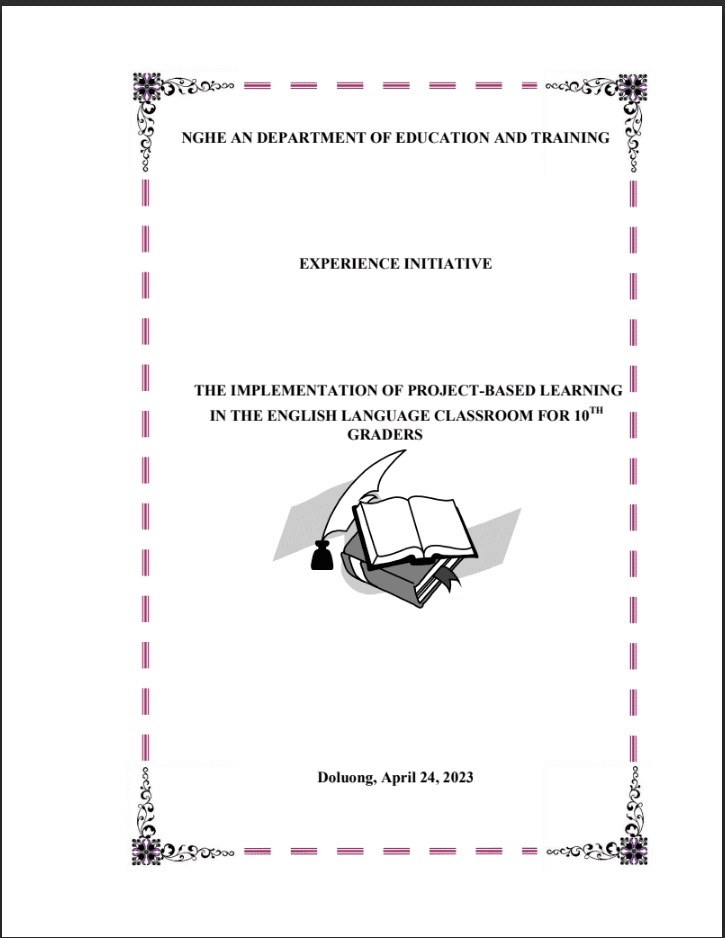SKKN “The implementation of project-based learning in the English language classroom for 10th graders.”
- Mã tài liệu: MP0087 Copy
| Môn: | Tiếng Anh |
| Lớp: | 10 |
| Bộ sách: | Global Success |
| Lượt xem: | 434 |
| Lượt tải: | 1 |
| Số trang: | |
| Tác giả: | Nguyễn Thị Hồng Anh |
| Trình độ chuyên môn: | Cử nhân đại học |
| Đơn vị công tác: | THPT Đô Lương 1 |
| Năm viết: | 2022-2023 |
| Số trang: | |
| Tác giả: | Nguyễn Thị Hồng Anh |
| Trình độ chuyên môn: | Cử nhân đại học |
| Đơn vị công tác: | THPT Đô Lương 1 |
| Năm viết: | 2022-2023 |
Sáng kiến kinh nghiệm ““The implementation of project-based learning in the English language classroom for 10th graders.””triển khai gồm các biện pháp nổi bật sau:
Mô tả sản phẩm
PART I: INTRODUCTION
- Rationale
Although „project‟ is not a new term that has recently „knocked for admittance at the entrance of educational terminology‟ (Kilpatrick, 1918) and project-based learning (PBL) is not a new or revolutionary idea in education. Never before has PBL gained such a great position in the classroom and such a high reputation in enhancing educational quality and effectiveness as today. Schools currently are very concerned about inspiring the shift from teacher-centered to learner-centered approach of teaching and learning. Additionally, PBL is brought not only into the classroom for undergraduates majoring in natural sciences and social sciences but also into the second and foreign language classroom. Although in second and foreign language teaching, the application of PBL is a relatively new trend, compared with the usage of this method of teaching in other fields, interest in PBL and its integration into second language is growing around the world.
In Vietnam, PBL has been receiving more and more interest in recent years, even in the English language classroom. Projects can be wonderful teaching tools. They can allow for a more student-centered environment, where teachers can guide students in their learning instead of using lectures to provide them with information. At Doluong I High School, the word „project‟ has become more and more familiar to both teachers and students. Students are strongly encouraged and supported to conduct research projects right from 10th grade. However, while most teachers have been using PBL in their language lessons for a long time, a few of them still find it a new way of working and are reluctant in making a change.
There are several reasons why the implementation of project-based learning in the English language classroom for 10th graders is an important and valuable pursuit. Firstly, project-based learning is an innovative and engaging approach to teaching and learning that encourages active participation and collaboration among students. This approach can help to cultivate critical thinking, problem-solving, and communication skills, which are essential for success in both academic and professional settings.
Secondly, project-based learning can be an effective way to promote language acquisition and development. By engaging in meaningful and authentic projects, students are exposed to a range of vocabulary, grammar structures, and language functions in context, which can enhance their overall language proficiency.
Thirdly, project-based learning can help to foster a sense of ownership and autonomy among students, as they take on responsibility for their own learning and work towards achieving their project goals. This can lead to increased motivation and engagement, as well as a deeper understanding and retention of the material.
Finally, the implementation of project-based learning in the English language classroom for 10th graders can align with broader educational goals and objectives, such as promoting cross-curricular connections, developing 21st-century skills, and encouraging lifelong learning. By providing students with opportunities to apply their language skills in meaningful and relevant ways, project-based learning can support their overall academic and personal growth.
After considering all the reasons above, I boldly conducted a study on “The implementation of project-based learning in the English language classroom for 10th graders.”
- The new factors of the research
Project-based learning has had the reputation of being important in bettering students‟ study. When learners work together on projects, they can solve problems and carry out projects that are similar to what they will later have to do outside the classroom. Moreover, they can also develop many of the skills desired by today’s employers, including the ability to work well with others, make thoughtful decisions, and solve complicated problems.
- The scopes and objectives of the research
+ In terms of scope of the study:
- The study will focus on 10th graders in English language classrooms.
- The study will explore the implementation of project-based learning as an alternative approach to traditional classroom instruction.
- The study will examine the impact of project-based learning on students’ language acquisition, engagement, and collaboration.
+ The objectives of the study:
- To investigate the effectiveness of project-based learning in facilitating students’ language acquisition in the English language classroom.
- To examine the impact of project-based learning on students’ motivation, engagement, and ownership of the learning process.
- To explore the role of collaboration and communication in project-based learning, and how these skills can be developed in the English language classroom.
- To identify the key factors that contribute to successful implementation of project-based learning in the English language classroom, and any challenges or barriers that may arise.
- To provide practical recommendations for educators and policymakers on how to effectively implement project-based learning in the English language classroom.
- Organization of the research
The structure of a study on the implementation of project-based learning in the English language classroom for 10th graders will include:
- Introduction: This section should provide an overview of the research problem, the rationale for the study, and the research questions. It should also include a brief literature review that highlights the theoretical and empirical background of the study.
- Methodology: This section should describe the research design, sample, data collection procedures, and data analysis methods. It should also discuss any potential limitations or ethical considerations of the study.
- Results: This section should present the findings of the study, including any quantitative or qualitative data, as well as any relevant statistical analyses or visualizations. It should also interpret the results in relation to the research questions and relevant literature.
- Discussion: This section should provide a critical analysis of the study’s findings, including their implications for theory, practice, and future research. It should also discuss any limitations of the study and suggest directions for future research.
- Conclusion: This section should summarize the main findings and contributions of the study, as well as any practical implications for educators or policymakers.
- References: This section should list all the sources cited in the study, following a specified citation style.
- Appendices: This section may include any supplementary materials, such as survey instruments, interview protocols, or data tables, that are not included in the main text.
- Research methodology
The study has been conducted through the following research methodology:
Experimental design: This methodology involves randomly assigning students to either a project-based learning group or a traditional classroom instruction group and comparing their language acquisition, engagement, and collaboration outcomes. The study could use pre- and post-tests to measure language proficiency, surveys to measure engagement, and classroom observations to measure collaboration.
Case study: This methodology involves selecting one or more English language classrooms that have implemented project-based learning and analyzing their language acquisition, engagement, and collaboration outcomes. The study could use interviews with teachers and students, classroom observations, and student
work samples to gather data.
Mixed-methods design: This methodology involves using both qualitative and quantitative methods to explore the research questions. For example, the study could use surveys and tests to gather quantitative data on language acquisition and engagement, as well as interviews and observations to gather qualitative data on collaboration and the implementation of project-based learning.
Action research: This methodology involves engaging teachers and students in the research process to collaboratively explore the effectiveness of project-based learning in the English language classroom. The study could involve teachers designing and implementing project-based learning activities, collecting data on student outcomes, and reflecting on the effectiveness of the approach.
Systematic review: This methodology involves conducting a comprehensive review of existing literature on project-based learning in the English language classroom and synthesizing the findings to draw conclusions and identify gaps in the research. The study could involve searching for and analyzing relevant studies using specific inclusion and exclusion criteria, and using meta-analytic techniques to synthesize the results.
TÀI LIỆU LIÊN QUAN
- 7
- 105
- 1
- [product_views]
- 5
- 173
- 2
- [product_views]
- 4
- 165
- 3
- [product_views]
- 4
- 129
- 4
- [product_views]
100.000 ₫
- 6
- 434
- 5
- [product_views]
100.000 ₫
- 2
- 507
- 6
- [product_views]
100.000 ₫
- 9
- 546
- 7
- [product_views]
100.000 ₫
- 4
- 409
- 8
- [product_views]
100.000 ₫
- 2
- 595
- 9
- [product_views]
100.000 ₫
- 0
- 538
- 10
- [product_views]















